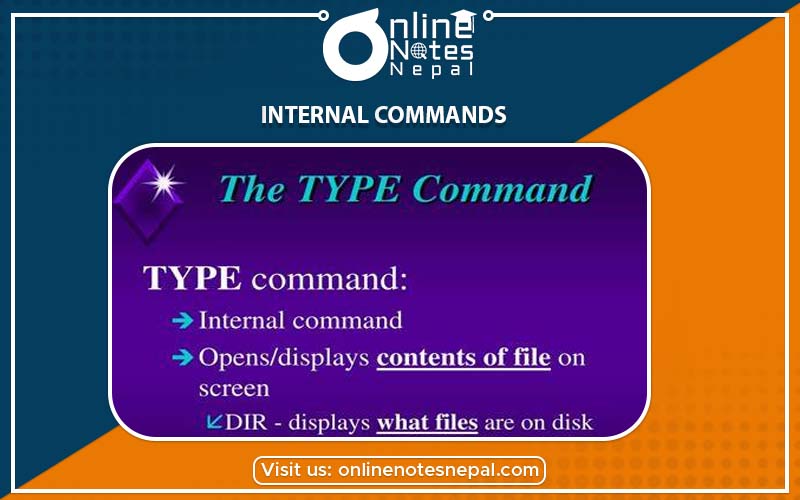Published by: BhumiRaj Timalsina
Published date: 21 Jan 2022

To change the default drive, simply the drive letter is typed at the prompt. The new default will be listed subsequent DOS prompts.
Syntax: [drive:]
Use: This command changes the current drive.
Example: C:/>A:
Output: The drive changes from C to A as A:/>
Syntax: DIR [drive] [switches]
Where, switches and their meanings are given below:
| Switch | Meaning |
| /P | Page-wise pausing |
| /W | Wide-wise pausing |
| /AD | Directories |
| /AH | Hidden files |
| /0 | Displays files/directories in sorted order with following specifications |
Use: displays files, directories and sub-directory.
Example: dir/p
Output: displays list of directory page wise
Syntax: Copy Con
Use: Used to create a text file.
Example: C:\> Copy Con Nepal.txt
Now type some text
Save: Press F6 Key or Press CTRL+z
Other Examples:
C:\>Copy Con REED.TXT
Now type some text
press F6 or (Ctrl+Z) to save it.
Syntax: TYPE
Use: Used to display content of a file.
Example: C:\>TYPE Nepal.txt
Output: This command display the information contained in the file name Nepal .TXT
Other Examples:
C:\>Type REED.TXT
Now you can view the content of REED.TXT
Syntax: COPY
Use: This command copies file(s) from one location to another.
Example: C:\>COPY Nepal china
Other Examples:
C:\>Copy RAMA.TXT B:
To copy Rama.txt file to drive B: working on C: drive.
C:\>Copy aa .txt + bb .txt + cc .txt +dd .txt
To merge the contents of aa.txt, bb .txt and cc.txt to a new filename dd.TXT
Syntax: REN
Use: Used to rename a file.
Example: A:\> REN nepal. Doc patan.doc
Output: This will rename the old file nepal.doc into patan.doc
Other Examples:
C:\>REN*.COM*.EXE
To rename all the files having .com as an extension into the extension .exe with the same primary file name of drive C.
Syntax: DEL filename
Use: Used to delete file(s)
Example: C:\>DEL try.exe
Output: It deletes try.exe file from drive C.
Other Examples:
C:\>DEL*.DOC:
To delete all the files having .doc as an extension of drive C:
C:\>DEL R*.*
To delete all the files starting with R having any extension of drive C:.
D:\>DEL Comp???:
To delete all the files having 7 characters long starting with Comp having .TXT as an extension of drive D.
Syntax:Date
Use: This command is used to display and change system date of computer.
Example: C:\>DATE
Output: Current date is sat 08-04-2004
Enter new date (mm-dd-yy):
Syntax:TIME
Use: This command is used to change and display the current system time of the computer.
Example: C:\>TIME
Output: Current time is 7:15:01.91
Enter new time:
Syntax: PROMPT [text or definition]
Use: This command is used to change MS-DOS prompt.
Example: C:\PROMPT $P$D$G
Output: C:\02-07-2010> is displayed prompt
| Prompt Symbol | Meaning |
| $Q | = (equal sign) |
| $$ | $ (dollar sign) |
| $D | Current date |
| $G | > (greater sign) |
| $T | Current time |
Syntax: VOL [drive]
Use: Used to display volume label name of a disk.
Example: C:\>VOL
Output: Volume in drive C is new Volume Serial Number is 8B9F-9BFA.
Syntax: VER
Use: Used to see the version of MS-DOS currently in use.
Example: C:\> VER
Output: Windows 98 [version 4.10.2222]
Syntax: MD< directory- name>
Use: Used to create a directory
Example: C:\>MD School
Output: A directory named "School" is created in root directory C.
Syntax: CD
Use: Used to change or get into the directory.
Example: C:\> CD School
Output: This command let us to go into directory School and we will be in C:\ School>
Syntax: CD..
Use: Used to escape from working directory.
Example: C:\School>CD.. or CD\
Output: It will escape from directory School to root directory C.
Syntax: RD [directory]
Use: Used to remove directory, but the directory must be empty.
Example: C:\>RD School
Output: It removes directory School, which is in C drive.